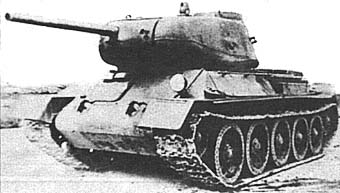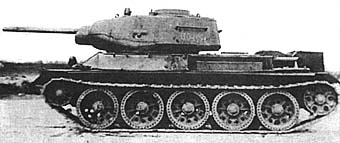|
By the middle of the war it had become clear that the Red Army did need a new medium tank. The military demanded a tank with maximum protection and minimum weight at the same time. These demands were implemented and the new medium tank project was completed by June 1943 under the name of T-43.

T-43 Medium Tank

T-43 Medium Tank |
The T-43 had a configuration like the T-34, it's glacis consisted of 75 mm of armor, and it's turretfront of 90 mm. The tank was armed with the 76.2 mm Tank Gun F-34. However, the total length of the engine&transmission compartment wasn't reduced, therefore the battle compartment remained very cramped. To increase internal space Soviet designers applied a torsion bar suspension which was more compact then the original Christie "candle" suspension. It was the first time that a torsion bar suspension was used for medium tanks.
Beginning in March 1943, two T-43 prototypes (preceded by vehicle T-43-1, which was built at the end of 1942. It possessed a driver's vision hatch, and had the commander's cupola displaced to the rear of the turret.) underwent trials.
These included combat trials with the NKSM Independent Tank Company. These showed that the T-43, because of its increased 34.1 ton weight, was marginally inferior to the T-34 in its ability to maneuver (maximum speed was decreased to 48 km/h). It did, however, significantly surpass the latter in smoothness of ride. The replacement of the eight side fuel tanks (on the T-34) for a smaller capacity fuel tank in the bow resulted in almost a 100km decrease in the radius of action. Tank crews praised the crew compartment and greater ease in operating the armament. After trials, the T-43 tank was recommended for acceptance by the Red Army at the end of the summer of 1943, but the results of the Battle of Kursk significantly altered this plan.
The armor protection was superior, compaired to the T-34, while it's armament was similar with the KV-1S heavy tank. However, the T-43 had a ground pressure like heavy tanks that adversely affected it's range and passability, but even worse was it's extreme construction, i.e. it didn't allow further modernisation. So, when production T-34's were rearmed with the 85 mm gun, the T-43 became obsolete. However, experience with the T-43 didn't get lost. The T-43's tests (3,000 km race) had clearly proved the superiority of the torsion bar suspension over the Christie's.
|
Sources:
S.Gryankin "The T-44", a historical issue in the "Tankomaster"
"Soviet tanks in combat 1941-1945. The T-28, T-34, T-34-85 and T-44", Concord publications company
|
|







